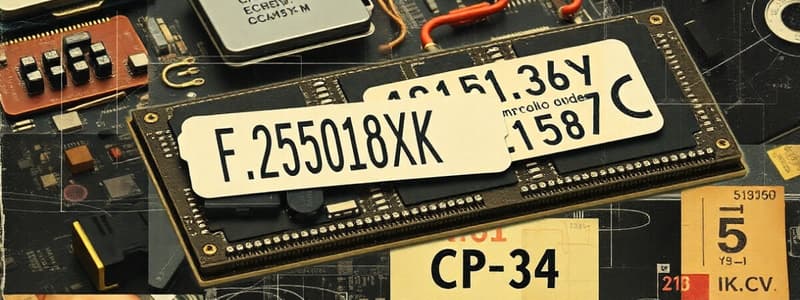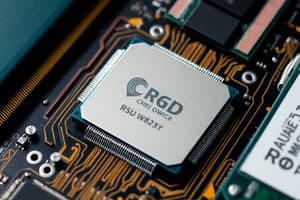Podcast
Questions and Answers
CPU का मुख्य कार्य क्या है?
CPU का मुख्य कार्य क्या है?
- कमप्यूटर की सभी भागों को जोड़ना
- डाटा संग्रहीत करना
- निर्देशों का निष्पादन करना (correct)
- तापमान नियंत्रित करना
RAM का मुख्य कार्य क्या है?
RAM का मुख्य कार्य क्या है?
- प्रोसेसिंग पावर बढ़ाना
- अस्थायी डाटा और निर्देशों का संग्रहण (correct)
- वीडियो निर्माण में मदद करना
- स्थायी डाटा संग्रहीत करना
मदरबोर्ड का मुख्य कार्य क्या है?
मदरबोर्ड का मुख्य कार्य क्या है?
- सभी कंप्यूटर घटकों को जोड़ना (correct)
- वीडियो को प्रोसेस करना
- तापमान कम करना
- डाटा को संग्रहीत करना
SSD और HDD में मुख्य अंतर क्या है?
SSD और HDD में मुख्य अंतर क्या है?
GPU का प्रमुख कार्य क्या है?
GPU का प्रमुख कार्य क्या है?
पावर सप्लाई यूनिट (PSU) का कार्य क्या है?
पावर सप्लाई यूनिट (PSU) का कार्य क्या है?
एक्सपेंशन कार्ड का मुख्य उद्देश्य क्या है?
एक्सपेंशन कार्ड का मुख्य उद्देश्य क्या है?
कूलिंग समाधानों का क्या महत्व है?
कूलिंग समाधानों का क्या महत्व है?
SSD और HDD में क्या मुख्य अंतर है?
SSD और HDD में क्या मुख्य अंतर है?
CPU की घड़ी की गति (Clock Speed) का क्या प्रभाव है?
CPU की घड़ी की गति (Clock Speed) का क्या प्रभाव है?
किसी कंप्यूटर की RAM क्षमता का क्या महत्व है?
किसी कंप्यूटर की RAM क्षमता का क्या महत्व है?
GPU प्रदर्शन किस प्रकार मापा जाता है?
GPU प्रदर्शन किस प्रकार मापा जाता है?
कंप्यूटर हार्डवेयर के लिए उचित कूलिंग क्यों महत्वपूर्ण है?
कंप्यूटर हार्डवेयर के लिए उचित कूलिंग क्यों महत्वपूर्ण है?
कंप्यूटर हार्डवेयर में 'फॉर्म फैक्टर' का क्या महत्व है?
कंप्यूटर हार्डवेयर में 'फॉर्म फैक्टर' का क्या महत्व है?
SSD के अधिक प्रयोग की भविष्यवाणी क्यों की जा रही है?
SSD के अधिक प्रयोग की भविष्यवाणी क्यों की जा रही है?
कंप्यूटर हार्डवेयर में संगतता क्यों महत्वपूर्ण है?
कंप्यूटर हार्डवेयर में संगतता क्यों महत्वपूर्ण है?
Flashcards
CPU
CPU
The computer's brain, executing instructions, managing data, and controlling other components.
RAM
RAM
Temporary storage for data and instructions the CPU is actively using.
Motherboard
Motherboard
Connects all computer components; providing electrical pathways and power distribution.
Storage Device
Storage Device
Signup and view all the flashcards
GPU
GPU
Signup and view all the flashcards
Input Device
Input Device
Signup and view all the flashcards
HDD
HDD
Signup and view all the flashcards
Output Device
Output Device
Signup and view all the flashcards
SSD (Solid State Drive)
SSD (Solid State Drive)
Signup and view all the flashcards
Optical Drive
Optical Drive
Signup and view all the flashcards
Clock Speed (CPU)
Clock Speed (CPU)
Signup and view all the flashcards
RAM Capacity
RAM Capacity
Signup and view all the flashcards
Storage Capacity
Storage Capacity
Signup and view all the flashcards
GPU Performance
GPU Performance
Signup and view all the flashcards
Form Factor (Computer)
Form Factor (Computer)
Signup and view all the flashcards
Hardware Compatibility
Hardware Compatibility
Signup and view all the flashcards
Study Notes
Computer Hardware Components
- Central Processing Unit (CPU): The "brain" of the computer, responsible for executing instructions. It performs calculations, manages data, and controls other components. Different types of CPUs have varying clock speeds and core counts, influencing processing power.
- Memory (RAM): Random Access Memory, temporary storage for data and instructions currently being used by the CPU. More RAM generally allows for more applications to run simultaneously without slowing down the computer.
- Motherboard: A printed circuit board that connects and interconnects all the computer components. It provides the electrical pathways for data transfer and power distribution. Crucial for system stability.
- Storage Devices: Include hard disk drives (HDDs), solid-state drives (SSDs), and optical drives (CD/DVD). HDDs use spinning platters, SSDs use flash memory, and optical drives use lasers. Storage devices hold data permanently. SSD speeds tend to be significantly faster than HDDs.
- Graphics Processing Unit (GPU): Specialised processor designed for rendering images and videos. GPUs are crucial for tasks like gaming, video editing, and 3D modeling, as they are considerably faster at these tasks than CPUs.
- Input Devices: Devices that allow users to interact with the computer, such as keyboards, mice, touchscreens, and scanners. Keyboards and mice are common input devices for text entry and navigation.
- Output Devices: Devices that display or present information from the computer, such as monitors, printers, and speakers. Monitors display visual information, printers create physical copies, and speakers produce audio.
- Power Supply Unit (PSU): Converts AC power from the wall outlet to the lower DC voltages required by computer components. Ensures proper power delivery, preventing component damage.
- Expansion Cards: Boards that can be added to the motherboard to expand computer functionality. Examples include sound cards, network cards, and video cards. Adding these cards enhances specific computer capabilities.
- Cooling Solutions: Crucial components that help regulate component temperatures. These include fans and heatsinks, and are necessary to prevent overheating.
Types and Characteristics of Storage Devices
- Hard Disk Drives (HDDs): Use spinning platters and read/write heads to store data. More affordable than SSDs but significantly slower. Data is organized in the form of tracks and sectors.
- Solid State Drives (SSDs): Use flash memory for data storage. Faster and more durable than HDDs but potentially more expensive. Often used in laptops and high-performance desktops.
- Optical Drives (CD/DVD/Blu-ray): Use lasers to read and write data on optical discs. Less practical for everyday storage but are commonly used for backups and distribution of files. The storage capacities vary depending on the disc type.
Computer Hardware Performance Metrics
- Clock Speed: Measures how fast the CPU can execute instructions, usually measured in GHz. Higher clock speed generally implies faster processing.
- RAM Capacity: The amount of RAM a computer has determines the number of applications that can run simultaneously without slowing down. Higher RAM capacity supports more programs to run efficiently.
- Storage Capacity: The total storage capacity of a computer impacts how many files, applications, and programs can be accommodated. Measured in GB or TB.
- GPU Performance: Measured in terms of processing speed, the number of cores, and memory capacity. High GPU performance is vital for graphics-intensive tasks.
Other Important Hardware Considerations
- Form Factors: The physical size and layout of computer components. Common desktop form factors include tower and mini-tower cases. Laptops have their own form factors.
- Connectivity: Includes ports like USB, HDMI, Ethernet, and Thunderbolt. These ports allow for connecting various devices and peripherals.
- Compatibility: Ensure hardware components are compatible with the motherboard and other crucial components to avoid compatibility issues.
- Heat Dissipation: Proper cooling is necessary to prevent overheating, vital for consistent performance and preventing component damage.
Future Trends in Computer Hardware
- Advancements in CPU Architecture: CPUs are becoming more efficient and powerful, often featuring multiple cores and advanced instruction sets.
- Increased SSD Adoption: SSDs are expected to become even more prevalent as storage technologies continue to evolve.
- Development of Specialized Hardware: Hardware is becoming more specialized for specific tasks and applications, including dedicated AI chips and accelerated computing units.
- Improved Power Efficiency: Hardware components are increasingly focusing on energy efficiency.
Studying That Suits You
Use AI to generate personalized quizzes and flashcards to suit your learning preferences.




